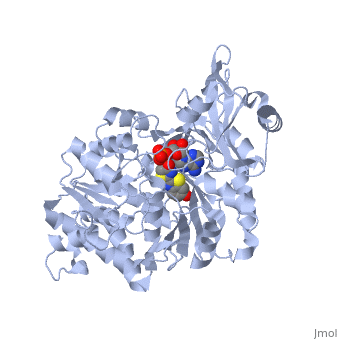User:Matt Whelihan
From Proteopedia
(→'''Firefly Luciferase''' (''Photinus pyralis'')) |
|||
| Line 1: | Line 1: | ||
== '''Firefly Luciferase''' (''Photinus pyralis'') == | == '''Firefly Luciferase''' (''Photinus pyralis'') == | ||
Bioluminescence is the process by which living organisms convert chemical energy into photons of light and it is widely distributed throughout the animals, plants and fungi. Species use bioluminescence as a survival tool in mating, defense and hunting. The one thing that all bioluminescent species have in common is that they all catalyze the reaction with an enzyme generically called a luciferase. All luciferases oxidize a substrate, which then decays back to the ground state while emitting a photon of light. This process is incredibly efficient with almost one photon of light produced per oxidation. While all lucifeases oxidize their substrates, the cofactors involved and reaction pathways used, vary widely. | Bioluminescence is the process by which living organisms convert chemical energy into photons of light and it is widely distributed throughout the animals, plants and fungi. Species use bioluminescence as a survival tool in mating, defense and hunting. The one thing that all bioluminescent species have in common is that they all catalyze the reaction with an enzyme generically called a luciferase. All luciferases oxidize a substrate, which then decays back to the ground state while emitting a photon of light. This process is incredibly efficient with almost one photon of light produced per oxidation. While all lucifeases oxidize their substrates, the cofactors involved and reaction pathways used, vary widely. | ||
| - | <applet load='1BA3' size=' | + | |
| - | <applet load='2d1r' size=' | + | The most studied of all luciferases is that of the North American firefly Photinus pyralis. This particular luciferase enzyme is located in the light emitting organ known as the lantern in the abdomen of the beetle. Firefly larvae glow green to ward off predators and adult fireflies use this mechanism of bioluminescence to attract mates. Luciferase binds ATP/Mg+ and D-luciferin and oxidizes it to Oxyluciferin with the products of one photon of yellow-green light, pyrophosphate, AMP and CO2. |
| + | [[Image:luciferins.jpg]] | ||
| + | <applet load='1BA3' size='350' frame='true' align='right' caption='FIREFLY LUCIFERASE IN COMPLEX WITH BROMOFORM' /> | ||
| + | |||
| + | <applet load='2d1r' size='350' frame='true' align='right' caption='Crystal structure of the thermostable Japanese firefly Luciferase complexed with OXYLUCIFERIN and AMP' /> | ||
I am a graduate student at the University of Vermont. My field of research is biochemistry. I am working on a Proteopedia page for a Protein Structure class under the supervision of Dr. Stephen Everse. | I am a graduate student at the University of Vermont. My field of research is biochemistry. I am working on a Proteopedia page for a Protein Structure class under the supervision of Dr. Stephen Everse. | ||
Revision as of 02:17, 7 April 2009
Firefly Luciferase (Photinus pyralis)
Bioluminescence is the process by which living organisms convert chemical energy into photons of light and it is widely distributed throughout the animals, plants and fungi. Species use bioluminescence as a survival tool in mating, defense and hunting. The one thing that all bioluminescent species have in common is that they all catalyze the reaction with an enzyme generically called a luciferase. All luciferases oxidize a substrate, which then decays back to the ground state while emitting a photon of light. This process is incredibly efficient with almost one photon of light produced per oxidation. While all lucifeases oxidize their substrates, the cofactors involved and reaction pathways used, vary widely.
The most studied of all luciferases is that of the North American firefly Photinus pyralis. This particular luciferase enzyme is located in the light emitting organ known as the lantern in the abdomen of the beetle. Firefly larvae glow green to ward off predators and adult fireflies use this mechanism of bioluminescence to attract mates. Luciferase binds ATP/Mg+ and D-luciferin and oxidizes it to Oxyluciferin with the products of one photon of yellow-green light, pyrophosphate, AMP and CO2. Image:Luciferins.jpg
|
|
I am a graduate student at the University of Vermont. My field of research is biochemistry. I am working on a Proteopedia page for a Protein Structure class under the supervision of Dr. Stephen Everse.

